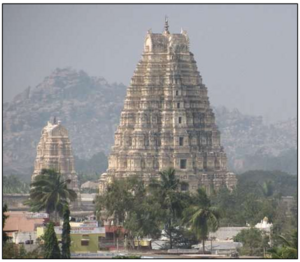Talk:Religious and Spiritual Reasons for Visiting Mandirs
By Vishal Agarwal
Mandirs are public places of worship[1][2]. Hindus visit Mandirs for the following religious and spiritual reasons:
- Pilgrimage: Several Mandirs mark the site of pilgrimages because of their religious and historical importance. For example, the Ramajanmabhoomi Temple marks the place of the incarnation of Bhagavān Rama, making it a pilgrimage destination for all Hindus.
- Worship with Others: As in Satsaṇga, people can come to Mandirs to worship with other members of the Hindu community and enhance their own spiritual experience. It also promotes a sense of belongingness and unity among Hindus.
- Sādhusaṇnga: Many temples are frequented by our Gurus, and one can meet them there conveniently for instruction or to get their blessings. Itinerant Sadhus often find temporary accommodation in the Mandir premises.
- Sevā-Perform Community Service: Numerous Mandirs have an infrastructure to provide free food, clothing, or shelter to the needy; run religious schools, Yog classes, and so on. Interested community members can offer their volunteering services if they wish to do so, or even avail of these services. In times of calamities, Mandir premises are used to house displaced victims.
- Dhārmic Education: Learn about dharm, arts, history, languages: Mandirs are repositories of our traditional architecture, art and are an important part of our history and culture. The practice of these arts employs thousands of artists. It is said that some of our classical dance forms themselves were revived in recent times by a study of the temple sculptures depicting the dance poses. Many temples have libraries of ancient manuscripts or rare religious scriptures. Weddings and weekend schools can be run conveniently within the Mandir premises.
- Religious Arts and Rites of Passage: Mandirs provide a venue for the performance of more elaborate religious ceremonies like Temple Festivals, large-scale Yajnas, and so on that cannot be performed by individual Hindus or families.
- Dharm-Kendra:
Several Mandirs are the never-center of specific Sampradāyas and are closely associated with their origin, evolution, growth, and so on. For example, the Tirupati and Anantapadmanabhaswamy Mandir (in Trivandrum) are important centers of Vaikhānasa Vaishṇava traditions. In some cases, the demolition of specific Mandirs has weakened certain Hindu traditions. For example, the ceremony of making offerings to maternal ancestors was carried out at Rudramahālaya Temple in Siddhapur (Gujarat), but the custom had shrunk to the pale glory of its former prominence when the temple was demolished and replaced with a mosque by Muslim invaders.
Some people question the utility of temples, but the criticism of temples is misinformed, as our teachers explain- Visiting and worshipping in Mandirs can accelerate the development of devotional feelings in our hearts and minds. Some people argue, ‘Why go to temples when we have a shrine in our home, and because the Divine resides within our heart?” To them, we must reply, “Why then go to sports stadiums to watch a Cricket match when you can get a better view on your TV? The reason for going to a stadium is that the atmosphere and the joy of watching cricket there is manifold more than watching it on your TV. Likewise, the environment of a Mandir is much more energizing and spiritualizing than your own home.”
Mahatma Gandhi had once said- “We, the human family, are not all philosophers. We are the earth, very earthly, and we are not satisfied with contemplating the invisible God. So, I ask you to approach temples not as if they represented a body of superstitions. We have to approach these temples in a humble and penitent mood.”
Just as we have specific areas to go to for a shower and clean our bodies, likewise, we need temples and āshramas to cleanse our ātman. Those who oppose the construction of Mandirs do not bat an eyelid when billions are spent on casinos, bars, brothels, and other dens of vice. The opposition of these people can only be due to the hatred that they have in their hearts for Dharm.
Temples have inspired not merely millions of lay Bhaktas but also numerous saints in the Hindu tradition. The Vithoba Mandir at Pandharpur is associated with several Sants like Nāmadeva, Jnāneshvara, and so on. The Guruvayoor temple inspired saints like Nārāyaṇa Bhattāripād, Poonthanam, and many others. Mandirs are virtually saint factories, and circuits of them serve as popular pilgrimage itineraries for followers of specific traditions. For example, the twelve Jyotirlinga shrines are visited by millions of devotees of Shiva (and Hindus in general) out of piety and to enhance their faith and devotion.

